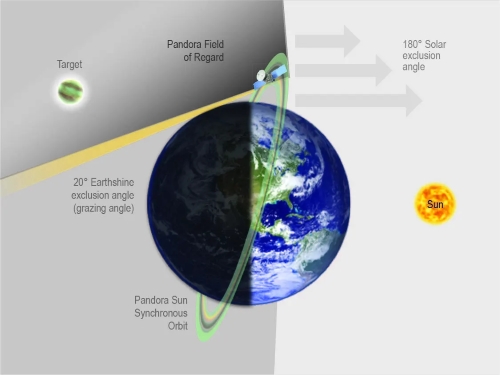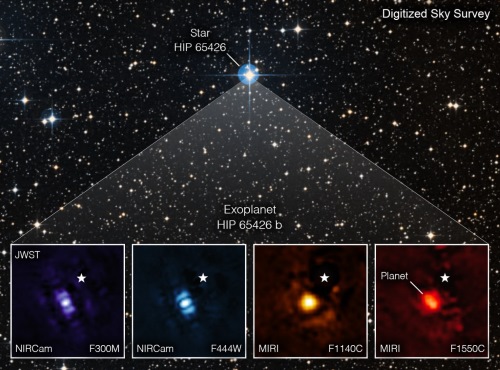NASA is set to launch its latest mission, Pandora, in 2025 to study the atmospheres of distant exoplanets. With the James Webb Space Telescope (JWST) oversubscribed, Pandora will play a crucial role in uncovering the secrets of distant planets by focusing on clouds, hazes, and water—key indicators of habitability.
Pandora, our newest exoplanet explorer, is closer to launch! Completing the spacecraft bus, which houses the brains of the spacecraft, is a big milestone. Pandora will help astronomers study distant worlds and the composition of their atmospheres. https://t.co/w6joksh2eY #AAS245 pic.twitter.com/WMU4fEUxi0
— NASA Universe (@NASAUniverse) January 16, 2025
Understanding exoplanets has been a central focus of modern astronomy, and Pandora aims to bridge gaps left by existing telescopes. By concentrating on prolonged observations of planetary transits, Pandora will help scientists refine exoplanet models, improving our understanding of planetary formation, evolution, and potential habitability in the universe.

Source: NASA
Overview
The upcoming mission aims to enhance our understanding of exoplanetary atmospheres by focusing on their composition, cloud formations, and potential habitability. By utilizing a specialized telescope, scientists will examine how light interacts with atmospheric particles, providing valuable insights into planetary climates and chemistry. This research will contribute to the broader study of exoplanet diversity and evolution.
| Feature | Details |
| Launch Date | Fall 2025 |
| Main Objective | Study the atmospheres of at least 20 exoplanets |
| Key Focus | Detection of hazes, clouds, and water in exoplanet atmospheres |
| Primary Tool | 17.7-inch (45 cm) aperture Cassegrain telescope |
| Comparison to JWST | Smaller and less sensitive but designed for prolonged observation |
| Primary Study Method | Transit method: Analyzing starlight passing through planetary atmospheres |
Also Read| What is NASA's PUNCH Mission? Know Key Details & Objectives
Also Read| Asteroid 2024 YR4 on NASA's Radar: What Are Near Earth Objects (NEOs)?
What are Pandora's Mission Objectives?
Before diving into Pandora's specific objectives, it is crucial to understand why exoplanet atmospheres matter. These distant worlds hold the key to understanding how planets form and whether life might exist elsewhere. By analyzing their atmospheres, scientists can detect vital molecules such as water vapor, methane, and carbon dioxide, which indicate potential habitability.
Mission Objectives
- Study Exoplanet Atmospheres: Analyze the atmospheres of 20 exoplanets (mostly gas giants and super-Earths). Investigate atmospheric compositions, including the presence of water vapor, methane, and other gases that may indicate habitability.
- Monitor Stellar Activity & Its Impact on Observations: Continuously observe host stars in both visible and infrared light to understand how their brightness fluctuations affect exoplanet studies. Helps differentiate between actual atmospheric features and stellar interference (such as starspots or flares).
- Support James Webb Space Telescope (JWST) & Other Exoplanet Missions: Complement data from JWST, Hubble, and other telescopes by providing continuous, long-duration observations of exoplanet transits. Improve the accuracy of exoplanet atmospheric models.
- Demonstrate SmallSat Capabilities in Exoplanet Science: Test how low-cost SmallSats can contribute to astrophysics and planetary science. Provide a blueprint for future low-budget, high-impact space missions.

Source: NASA
Why Pandora Matters?
The hunt for habitable planets has intensified in recent years. While JWST and previous missions like Kepler have discovered thousands of exoplanets, long-duration observations remain a challenge. Pandora attempts to address this gap, allowing astronomers to conduct detailed studies without competing for limited JWST observation time.
- Addressing JWST’s Limitations: JWST, though powerful, is heavily oversubscribed, with astronomers requesting 78,000 hours across 2,377 proposals, far exceeding available time. Pandora helps by focusing on long-duration observations, which JWST cannot accommodate.
- The Search for Water Worlds: Water is essential for life. Pandora will analyze exoplanets for Water vapor, Cloud compositions, and Atmospheric conditionsAccording to Ben Hord from NASA’s Goddard Space Flight Center, “The presence of water is a critical factor in determining a planet’s habitability.”
- Small Satellite, Big Potential: Unlike JWST, Pandora is a small satellite but has a crucial advantage: patience. It will stare at host stars longer, enabling detailed atmospheric studies over extended periods.
How Pandora Detects Exoplanet Atmospheres?
Understanding exoplanet atmospheres is challenging, but Pandora's mission is designed to overcome these difficulties. By using the Transit Method, Pandora can capture the chemical fingerprints of exoplanets as they pass in front of their host stars, providing unprecedented insights into their compositions.
Pandora uses the Transit Method, where a planet passes in front of its host star, allowing starlight to filter through its atmosphere. This technique helps identify:
- Gases in the atmosphere (water vapor, methane, etc.)
- Planetary compositions (rocky, gaseous, icy)
- Potential habitability

Source: NASA
"By measuring changes in starlight during a transit, Pandora will reveal the chemical fingerprints of exoplanet atmospheres," says Daniel Apai, a Pandora co-investigator from the University of Arizona.
Also Read| What is Blue Ghost Lander? Check Its Objective and Significance in Details
The Science of Exoplanets
Exoplanets are more than just distant worlds; they hold clues to planetary formation, atmospheric dynamics, and the conditions necessary for life. NASA has confirmed thousands of these planets, but many remain unstudied due to the complexity of atmospheric analysis.
What is Exoplanets?
All planets within our solar system revolve around the Sun. Planets that orbit stars outside our solar system are known as Exoplanets. An Exoplanet refers to any planet located beyond our solar system. The term "Exoplanet" encompasses any planet that resides outside the boundaries of our solar system. While most exoplanets orbit distant stars, some, known as rogue planets, drift freely through space without being gravitationally bound to any star. Detecting exoplanets with telescopes is challenging because their faint light is often overshadowed by the intense brightness of the stars they orbit.NASA has confirmed over 5,800 exoplanets out of billions that likely exist.

Source: NASA
How Do We Find Exoplanets?

Source: NASA
- The "wobble method," also known as the radial velocity method or Doppler spectroscopy, is a technique used in astronomy to detect exoplanets (planets orbiting stars outside our solar system). It relies on the subtle gravitational influence that an orbiting planet exerts on its host star. As a planet orbits, it causes the star to wobble slightly. This wobble creates a Doppler shift in the star's light spectrum, which astronomers can measure to infer the presence of the planet, estimate its mass, and determine its orbital period. The wobble method is effective at detecting large planets but is less sensitive to smaller, Earth-like planets.
- Another method used by Scientists is the Transit method to find exoplanets. They look for dips in a star's brightness, which happens when a planet passes in front of it. This method helps them figure out a planet's size, how long it takes to orbit its star, how far away it is from its star, what its atmosphere is made of, its density, and if it could support life.
- NASA's Kepler Mission, which operated from 2009 to 2018, was dedicated to discovering exoplanets, planets orbiting stars outside our solar system, with a focus on finding Earth-size planets in habitable zones. The mission used the transit method, observing dips in a star's brightness as a planet passed in front of it. Kepler discovered thousands of exoplanet candidates, greatly expanding our knowledge of planetary systems. Its discoveries included a wide range of exoplanets, including potentially habitable "Goldilocks" planets with liquid water. Kepler's legacy includes paving the way for future exoplanet missions and inspiring new scientists and engineers to continue the search for extraterrestrial life.

Source: NASA
Pandora’s Special Role in Exoplanet Science
While many space telescopes contribute to exoplanet discovery, Pandora is uniquely designed to refine our understanding of planetary atmospheres. Its long-duration observations and ability to separate stellar interference from planetary signals set it apart from previous missions.
- Solving the "Lucky Light" Problem: Light from a star interferes with signals from an exoplanet's atmosphere, making water detection difficult. A phenomenon discovered in 2018, this effect limits JWST’s capability. Pandora will separate starlight variations from planetary signals, leading to more accurate atmospheric analysis.
- Long-Duration Observations: The Pandora mission will conduct extensive observations of all its designated exoplanet targets, with each of the 20+ planets being observed for a minimum of 10 separate sessions. Each observational session is planned to span a full 24-hour period, ensuring the collection of comprehensive and continuous data throughout a complete planetary day-night cycle.
- Supporting JWST’s Findings: The Pandora instrument, designed to differentiate between planetary signals and the inherent noise produced by stars, will significantly enhance the research capabilities of the James Webb Space Telescope (JWST). By enabling a more precise identification and characterization of exoplanets, Pandora will contribute to the refinement and advancement of exoplanet models. This will allow for a deeper understanding of the formation, evolution, and atmospheric composition of planets beyond our solar system.

Source: NASA
Conclusion
Pandora marks a significant step in exoplanet research, offering long-duration, high-precision studies of distant worlds. While JWST captures breathtaking cosmic images, Pandora will work patiently to decode the atmospheres of alien worlds, bringing us closer than ever to answering the ultimate question: Are we alone in the universe?
Astronomers eagerly await Pandora’s findings, as they could reshape our understanding of habitable planets. By identifying key atmospheric components and refining JWST's discoveries, Pandora will contribute significantly to the search for alien life.
Looking Ahead
- Pandora’s launch in 2025 will expand our understanding of habitable planets.
- Future missions, combined with Pandora’s data, could identify Earth-like planets with conditions suitable for life.
Comments
All Comments (0)
Join the conversation